| how to choose the right circuit breaker |
| how to choose a circuit breaker |
| how to choose cable size and circuit breaker |
| how to choose circuit breaker rating cable size and circuit breaker selection chart allen bradley circuit breaker selection guide cable size and circuit breaker selection pdf circuit breaker selection calculation circuit breaker selection calculation pdf circuit breaker selection chart circuit breaker selection guide how to select a circuit breaker how to select circuit breaker how to select circuit breaker size motor protection circuit breaker selection guide selection of circuit breaker siemens circuit breaker selection guide abb circuit breaker selection guide circuit breaker selection circuit breaker selection criteria circuit breaker selectivity how to select circuit breaker rating how to select rating of circuit breaker miniature circuit breaker selection guide motor circuit breaker selection schneider circuit breaker selection schneider circuit breaker selection guide selection of circuit breaker in power system selection of circuit breaker in power system pdf siemens motor protection circuit breaker selection guide |
In today’s world, where electricity powers almost every aspect of our lives, ensuring the safety and efficiency of electrical systems is paramount. One crucial component of any electrical system is the circuit breaker. But with so many options available, how do you choose the right one for your specific needs?
In this comprehensive guide, we’ll explore everything you need to know about selecting the perfect circuit breaker for your home or business.
Definiton: What is a Circuit Breaker

Before diving into the specifics of choosing a circuit breaker, let’s first understand what it is and how it works.
A circuit breaker is a safety device designed to protect electrical circuits from damage caused by excess current flow. When an abnormal electrical condition occurs, such as a short circuit or overload, the circuit breaker automatically interrupts the flow of electricity to prevent damage to the wiring and electrical devices.
Types of Circuit Breaker

When selecting a circuit breaker, it’s essential to consider the different types and categories available. Here are some key classifications to be aware of:
Residential Circuit Breakers
These circuit breakers are designed for use in residential buildings and are typically installed in distribution boards or breaker panels. They come in various sizes and configurations to accommodate different voltage and current requirements.
Commercial Circuit Breakers
Commercial circuit breakers are built to withstand higher electrical loads commonly found in commercial or industrial settings. They offer increased protection and durability compared to residential circuit breakers.
Specialized Circuit Breakers
In addition to standard residential and commercial circuit breakers, there are also specialized options available for specific applications. These include ground fault circuit interrupters (GFCIs), arc fault circuit interrupters (AFCIs), and surge protection devices (SPDs).
How to Choose Circuit Breaker

Selecting the right circuit breaker is crucial for ensuring the safety and reliability of your electrical system.
Here’s a step-by-step guide to help you how to select a circuit breaker:
1. Identify the Application:
Determine the specific application or purpose for which the circuit breaker is needed. Consider whether it’s for residential, commercial, or industrial use.
2. Determine Voltage and Current Ratings:
Understand the voltage and current requirements of the circuit. Choose a circuit breaker with voltage and current ratings that match or exceed the specifications of the electrical system.
3. Determine Type of Protection Needed:
Consider the type of protection required for the circuit. Decide whether you need overload protection, short circuit protection, ground fault protection, or a combination of these.
4. Select the Trip Curve:
Choose the appropriate trip curve based on the characteristics of the load. Different trip curves provide varying levels of sensitivity to overloads and short circuits.
5. Consider Environmental Factors:
Take into account the environmental conditions in which the circuit breaker will operate. Ensure that the circuit breaker is suitable for the temperature, humidity, and other environmental factors present in the installation location.
6. Evaluate Size and Mounting Requirements:
Determine the physical size and mounting requirements of the circuit breaker. Ensure that it fits within the available space and can be mounted properly in the electrical panel or enclosure.
7. Check Compliance with Standards:
Verify that the circuit breaker meets relevant industry standards and certifications. Look for certifications such as UL listing, CSA certification, or IEC compliance to ensure safety and reliability.
8. Consider Future Expansion:
Anticipate future changes or expansions to the electrical system. Choose a circuit breaker with sufficient capacity and flexibility to accommodate future additions or modifications.
9. Budget Considerations:
Consider the cost of the circuit breaker and how it fits within your budget. Balance the upfront cost with the long-term benefits of reliability and safety.
10. Seek Professional Advice if Needed:
If you’re unsure about which circuit breaker to choose or if you’re dealing with a complex electrical system, don’t hesitate to consult with a qualified electrician or engineer for expert advice.
By following these steps and considerations, you can select the right circuit breaker for your specific needs, ensuring optimal performance, safety, and reliability in your electrical system.
How to Choose Circuit Breaker Size
Selecting the appropriate circuit breaker size is essential for maintaining the safety and efficiency of your electrical system. Here’s a step-by-step guide to help you choose the right size:
1. Determine Total Load:
Calculate the total electrical load of the circuit by adding up the wattage of all devices and appliances connected to it.
2. Consider Voltage Rating:
Choose a circuit breaker with a voltage rating that matches the voltage of your electrical system.
3. Calculate Current Rating:
Divide the total load (in watts) by the voltage (in volts) to determine the maximum current expected in the circuit.
4. Account for Inrush Current:
Take into consideration any inrush current during the startup of devices, which may require a higher-rated circuit breaker to handle temporary current spikes.
5. Select Circuit Breaker Type:
Choose the appropriate type of circuit breaker based on your application requirements, such as miniature circuit breakers (MCBs) for residential use or molded case circuit breakers (MCCBs) for industrial applications.
6. Determine Trip Characteristics:
Select the trip characteristics (e.g., instantaneous, short delay, long delay) based on the specific protection needs of your circuit.
7. Refer to National Electrical Code (NEC):
Consult the NEC guidelines and regulations to ensure compliance with safety standards and code requirements when selecting the circuit breaker size.
8. Oversize for Safety Margin:
Consider selecting a slightly higher-rated circuit breaker to provide a safety margin and prevent nuisance tripping.
9. Seek Professional Advice:
If you’re unsure about which circuit breaker size to choose or if you’re dealing with complex electrical systems, seek advice from a qualified electrician or engineer.
10. Test and Verify:
After installation, test the circuit breaker to ensure it functions correctly and provides adequate protection against overloads and short circuits.
By following these steps, you can confidently choose the right circuit breaker size for your electrical system, ensuring optimal performance, safety, and reliability.
Circuit Breaker Selection Guide
Choosing the right circuit breaker is crucial for the safety and reliability of your electrical system. Here’s a comprehensive guide to help you navigate through the selection process:
1. Understanding Circuit Breakers:
- Familiarize yourself with the different types of circuit breakers available, including miniature circuit breakers (MCBs), molded case circuit breakers (MCCBs), residual current circuit breakers (RCCBs), and more. Each type offers unique features and functions suited for specific applications.
2. Identifying Application Requirements:
- Determine the specific needs and requirements of your electrical system. Consider factors such as voltage and current ratings, type of protection needed (e.g., overload, short circuit, ground fault), environmental conditions, and installation location.
3. Calculating Load and Current Ratings:
- Calculate the total electrical load of the circuit by summing up the wattage of all connected devices and appliances. Then, determine the maximum current expected in the circuit by dividing the total load by the voltage.
4. Considering Trip Characteristics:
- Select the appropriate trip characteristics of the circuit breaker based on the specific protection needs of your circuit. Consider factors such as the type of load, sensitivity to overloads or short circuits, and desired response time.
5. Evaluating Environmental Factors:
- Take into account the environmental conditions in which the circuit breaker will operate. Ensure that the circuit breaker is suitable for the temperature, humidity, and other environmental factors present in the installation location.
6. Consulting National Electrical Code (NEC):
- Refer to the NEC guidelines and regulations to ensure compliance with safety standards and code requirements. Verify that the selected circuit breaker meets the applicable NEC requirements for your installation.
7. Selecting Size and Mounting:
- Choose a circuit breaker with the appropriate size and mounting configuration to fit within the available space and installation requirements. Consider factors such as physical dimensions, form factor, and mounting options.
8. Verifying Certification and Compliance:
- Verify that the circuit breaker meets relevant industry standards and certifications, such as UL listing, CSA certification, or IEC compliance. Ensure that the circuit breaker is certified for safety and reliability.
9. Budget Considerations:
- Consider the cost of the circuit breaker and how it fits within your budget. Balance the upfront cost with the long-term benefits of reliability, safety, and performance.
10. Seeking Professional Advice:
- If you’re unsure about which circuit breaker to choose or if you’re dealing with complex electrical systems, seek advice from a qualified electrician or engineer. They can provide expert guidance and recommendations based on your specific needs and requirements.
By following this circuit breaker selection guide, you can make informed decisions and choose the right circuit breaker for your electrical system, ensuring optimal performance, safety, and reliability.
Conclusion
In conclusion, choosing the right circuit breaker is essential for maintaining a safe and reliable electrical system. By understanding the different types and categories available, recognizing common symptoms and signs of electrical problems, and taking preventive measures, you can ensure the safety and efficiency of your home or business’s electrical infrastructure. Remember to consult with qualified